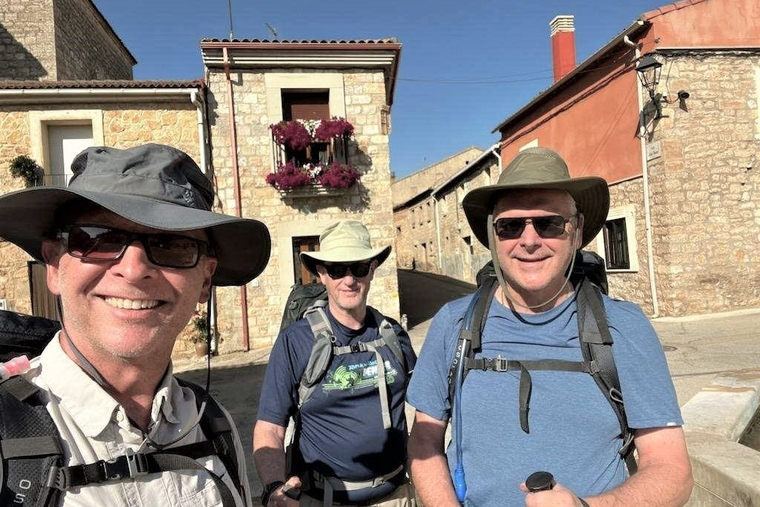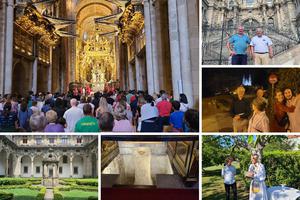The Camino Compadres: 3 US Bishops Find Spiritual Refreshment and Fraternity Via Ancient Pilgrimage
Archbishop Paul Coakley and Bishops James Conley and James Wall share highlights from their recent experience on El Camino de Santiago in Spain — the fifth time for two of them — and their recommendations for pilgrimages closer to home.

These days, you can encounter just about anyone walking the Camino de Santiago. Although the practice originated as a Christian pilgrimage in the ninth century, the pool of participants has expanded well beyond practicing Catholics in recent decades, in part due to the notoriety that comes with being added to the UNESCO World Heritage List and being featured in film, like 2010’s The Way, starring Martin Sheen. The government of Spain even promotes the walking pilgrimage as a tourist activity.
This makes one group that just completed El Camino somewhat remarkable, at least in contemporary times: three U.S. bishops, with no entourage and no agenda, other than prayerfully journeying together on the ancient Way of St. James.
The bishops in question — Archbishop Paul Coakley of Oklahoma City, Bishop James Conley of Lincoln, Nebraska, and Bishop James Wall of Gallup, New Mexico — walked about 200 miles over the course of two and a half weeks, reaching their destination on Sept. 1. As Bishop Wall told the Register via a video interview with all three bishops, they were somewhat of an “unusual group.”
But although some travelers were surprised to encounter a trio of bishops on the road, the three are no strangers to El Camino, which perhaps could be called “Los Caminos,” given that it actually refers to a network of different walking routes crisscrossing Spain, Portugal and France, all leading to Santiago de Compostela — and the tomb of the apostle St. James the Greater.
For Archbishop Coakley and Bishop Wall, this was the fifth portion of the pilgrimage they’ve completed together. By walking the middle portion of the Camino Frances, or “The French Way,” they’ve now finished all 500 miles of the popular route.
Bishop Conley joined them in 2012 for the last stretch of the Camino Frances and has also completed another leg on his own, while Archbishop Coakley and Bishop Wall have also done the Camino Portuguese and the Camino Primitivo, the original route that starts near the northern coast of Spain.
Adding up the mileage from their five journeys, Archbishop Coakley and Bishop Wall have now walked 840 Camino miles together.
“This is something I’ve kind of gotten hooked on,” the Oklahoma City archbishop told the Register.

‘Time Slows Down’
But in all those miles, these Camino compadres say they’ve never met a fellow bishop. So what keeps bringing them back?
For one, the three bishops appreciate the opportunity to go on pilgrimage to the final resting place of one of their most illustrious predecessors, St. James, apostle of Christ.
“As successors of the apostles, I think we felt a kinship with him and his witness,” explained Archbishop Coakley.
It also doesn’t hurt that two of the bishops share a name with the apostle, their baptismal patron.
But a good part of the appeal is the opportunity the Camino provides to, in the words of Bishop Conley, “disengage with your everyday life” and just walk.
“Time slows down,” the Lincoln bishop told the Register. “Everything becomes magnified: weather, night, day, people, villages, and then you just walk ‘The Way.’ You’ve got time to yourself to just contemplate.”
Bishop Wall compared the journey to a retreat, characterized by long stretches of silence on the road as they passed through plains and fields of wheat and corn of northern Spain.
“We walk together, but we don’t walk together,” he explained. “You could walk for an hour and not say a word or hear someone speak.”
While the bishops were away from their dioceses and the typical daily demands faced by modern-day diocesan bishops, the people back home were not out of mind. Much of their time was spent praying for individuals and groups and ministries back in their dioceses — from seminarians to Catholic schools. Bishop Conley, for instance, shared on Facebook who he was praying for as the bishops progressed in their journey.
And as Archbishop Coakely wryly noted, walking 15-24 miles a day gives you plenty to offer up on behalf of others.
“Maybe it’s the pain in your back or a pain in your foot, or something that puts you in mind of other people’s sufferings, and to unite our own suffering or inconveniences with those of others and offer them to the Lord,” he explained. “There’s a lot to pray about.”
Together on ‘The Way’
Of course, not all of the bishops’ time on El Camino was spent in silent prayer. Another important dimension was engaging with those they encountered along the way.
The bishops said they met all kinds of pilgrims, including travelers from Korea, Ireland and even Tulsa, Oklahoma.
Despite the geographical diversity, these walkers of “The Way” share one thing in common. For the most part, they’re not practicing Catholics. Bishop Conley estimated that 80% of the people who walk the Camino “either have no faith at all or are not Catholic.”
“So they’re doing it for various reasons, but at the same time, they have this understanding that this is a religious thing, this is a spiritual experience, and it’s great.”
Bishop Wall shared that fellow pilgrims would sometimes discover their identity, but often in a surprising way. Because the bishops wore regular hiking clothes while walking the Camino, it sometimes wasn’t until the celebration of the evening Mass that others would realize who they had been walking with, “and their eyes are wide open when we come walking out.”
“I love when people find out who we are or what we are because it really opens up some great conversations,” the Gallup bishop told the Register.
Bishop Conley also liked it when the bishops “blow our cover,” because it provided them with an opportunity to go deeper into the significance of what they were all doing together: heading to the tomb of an apostle of Jesus Christ, “who was a personal friend of his.”
“And for some, it’s ‘Oh, really? Is that what this is all about?’ It’s an opportunity to start a conversation,” he said.
In some cases, though, it’s not the bishops providing counsel to others, but others providing the bishops with a bit of assistance.
Archbishop Coakley recalled that, on their first experience of the Camino, they got off a bus from Madrid — and immediately started heading in the wrong direction. Some local people flagged them down, saying, “You’re going the wrong way, pilgrim,” and set them on the right course.
“So they look out for us.”
Brother Bishops
In addition to engaging with new people along the way, the bishops also spent a good amount of time in conversation with another group — each other. They described their journey together on the Camino as an important time of fraternity and deep friendship — something that can be difficult to come by for diocesan bishops.
“In our own diocese we’re kind of the guy at the top, so we don’t really have anybody we can go to,” explained Bishop Conley, noting how there aren’t the same opportunities for a bishop to have fraternal relations among peers in a diocese as he may have had when he was a priest. “But when we’re together like this, we have an opportunity just to kind of be ourselves and not be ‘the bishop.’”
“To be with one another and kind of put a suspension on things at home, it’s just a great gift,” explained Bishop Wall, who noted that the bishops’ conversations were sometimes about spiritual topics or personal matters, but were also sometimes just about “things that strike us as being funny.”
“We’re able to just kind of open our hearts and talk to each other about things that are challenging,” added Bishop Conley. “It’s just a great way to receive that support and strength and advice and counsel about our work as bishops and our life as bishops — that we’re not alone.”

‘Pilgriming’ Closer to Home?
The Camino de Santiago may be unique among pilgrimages in terms of its fame and the number of walkers it attracts each year, but it’s also an instance of what all forms of Christian pilgrimage can offer.
“It’s a physical reminder of a life of discipleship,” said Archbishop Coakley. “We’re not just wandering aimlessly; we’re following the Lord. There’s a direction; there’s a purpose; there’s a goal.”
Archbishop Coakley noted how beautiful it was to see their fellow pilgrims as they arrived at the Cathedral of Santiago de Compostela, many simply collapsing, weeping and sharing hugs and other gestures of joy.
“So I think that’s the journey; it’s an image of what our Christian life is all about.”
Pilgrimages are an ancient part of Catholic culture, so, unsurprisingly, most of the best-known routes are in Europe and the Middle East, where the roots of Christianity run deep. But the bishops also note that the practice of walking pilgrimages is growing in popularity in the U.S., and they have recommendations for those looking to go on pilgrimage closer to home.
Archbishop Coakley notes that, in his own archdiocese, there are plans to turn the soon-to-be dedicated Shrine of Blessed Stanley Rather into a place of pilgrimage. Father Rother was a priest of the Archdiocese of Oklahoma City who was killed in 1981 in Guatemala, making him the first officially confirmed U.S.-born martyr.
For his part, Bishop Conley pointed to the Three Hearts Pilgrimage, a two-day, 35-mile trek to Our Lady of Clear Creek Abbey in eastern Oklahoma. Bishop Conley said this pilgrimage, which starts this year on Oct. 20, is especially popular for fathers to make with their sons.
Finally, Bishop Wall pointed to the Santuario de Chimayó in northern New Mexico, a place that has been described as “the Lourdes of America” due to the “holy dirt” believed to have healing powers found at the shrine.
Chimayó attracts 300,000 pilgrims annually, most visiting during Holy Week, and some walking the 90 miles from Albuquerque.
Pilgrimage in other parts of the country include a pilgrimage to Our Lady of Good Help — the only officially approved Marian apparition site in the U.S. — in northeastern Wisconsin, one to Florida’s Shrine of Our Lady of La Leche that is especially popular among mothers, and a four-day walking pilgrimage from northwestern New Jersey to the National Shrine of Our Lady of Czestochowa just north of Philadelphia.
Although the Camino compadres are seasoned pilgrimage vets, they acknowledge that the prospect may be daunting for those who have never made one. On this front, they share some practical advice.
Archbishop Coakley advises would-be pilgrims to “take care of your feet,” while Bishop Conley encourages pilgrim novices to not be intimidated; the three bishops encountered both people in their 80s and families with their young kids during this year’s Camino.
“If you can walk, you can do a pilgrimage,” said Bishop Conley, while Bishop Wall added that even those in wheelchairs can make a pilgrimage, referencing the film I’ll Push You, which documented one man pushing his wheelchair-bound friend the full 500 miles of the Camino Frances.
Like the Christian life, a pilgrimage isn’t about how fast you go or how many inconveniences you avoid, but that you remain faithful to the Way.
- Keywords:
- camino de santiago
- bishop james conley
- bishop james wall
- archbishop paul coakley
- pilgrimage
- jonathan liedl

















